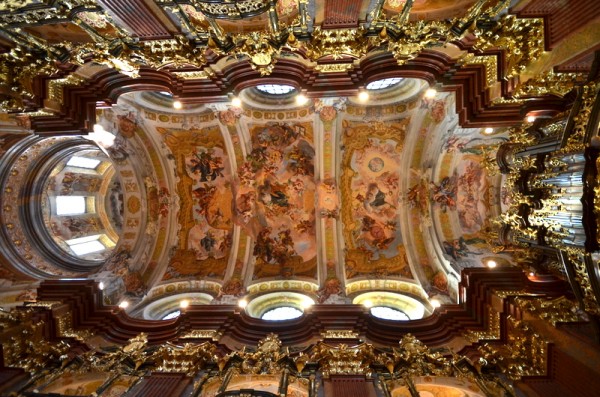Huge churches, like large corporations, great countries and complex universities, seem to have "always been there." But you don't have to be a scholar of history to realize that these institutions have humble beginnings, growth spurts, downturns, even coming close to dissolution.
Think about American corporations which were at one time immense, and no longer exist (Compaq, Enron, Woolworth, Standard Oil, Arthur Anderson, E.F. Hutton and many airlines--Eastern, Pan Am, TWA, USAir). Think about the humble beginnings of our own country, and that we have only been a world power post-World War II. Think about the handful of students who were taught in 1789, which over two centuries became the University of Pittsburgh.
Monasteries are similar, with rises and falls bigger than a roller coaster.
Such was the case with the Melk Abbey (Stift Melk) in the Wachau Valley of the Danube River, currently governed by Austria.
Our floating hotel, the Viking Prestige, coasted for two hours through the Wachau Valley, with its steep hillsides filled with abundant vineyards, occasional manors and the odd abandoned, crumbling castle. It was sunny and warm, and almost every passenger was on the sun deck taking pictures and enjoying the gentle river cruising. We came to a confluence of three rivers, the Melk and the Pietach flowing into the Danube. Towering over the small town and the river valley is the Melk Abbey.
Archaeologists note that human habitation of this site goes back to the Stone, Bronze and Iron Ages. During the Roman Empire there was a small fort. Christianity came to the region sometime in the 8th century. Charlemagne allegedly was in Melk about the year 791. The bishops of Eichstatt, Passau and Salzburg were involved in pastoral care of towns in the area during the 9th and 10th century.
The actual date of the first monastery in Melk is shrouded by history, but dates at least to 831, perhaps earlier. It is known that by 960 Melk was one of several "marks," that is, a territorial organization designed for defense by the local ruler. According to the history booklet "Stift Melk," a mark was "a fortress, not only a military center, but a spiritual [parish] and economic [markets were held next to the fortress] center as well."
Benedictine monks supplanted the canons regular living on the cliff above the river and began the Melk Abbey we we know it on March 21, 1089. The Melk library still has the venerable copy of the Rule of St. Benedict which the monks brought with them from Lambach.
Here is where the roller coaster begins. Over the next millennium, the abbey rose and fell, according the leadership quality of the abbot, the presence or absence of war, and the vagaries of fire. A massive church was constructed on the site, and a school dates from at least 1160. In the 14th and 15th centuries the abbey was in great decline, at one time comprised of only three priests and two brothers. Duke Albrecht V and Abbot Nikolaus Sayringer began a reform which brought the abbey out of debt, and more importantly, brought new men, clear vision and orthodoxy to the monastery. A new church was consecrated in 1429. This church was torn down and a new, Baroque church begun in 1702 by Abbot Berthold Dietmayr, who governed for 39 years. It is this church which we were privileged to see.
One definition of "baroque" is "extravagantly ornate, florid and convoluted in style." The Melk Abbey and Church is certainly that. You are overwhelmed by the size of statues, brilliant colors, exaggerated poses of figures, and overall impression of artists who were on drugs when they designed and executed their work. A contemporary restoration (1978-87) has brought light and shine to every altar, fresco and statue. Take a look at these images.
This is the ceiling of the church.
The library and the Marble Room were also incredible feasts for the eye. Here is the frescoed ceiling of the Marble Room.
One short blog post cannot do justice to this site of beauty, prayer and faith. We were able to give several hours to the tour of Melk Abbey and Church, and I am glad we did.









No comments:
Post a Comment